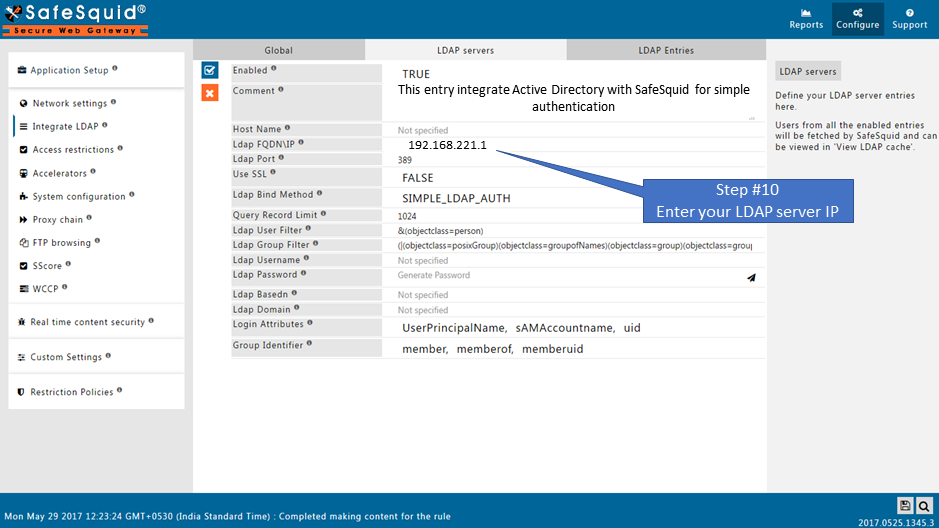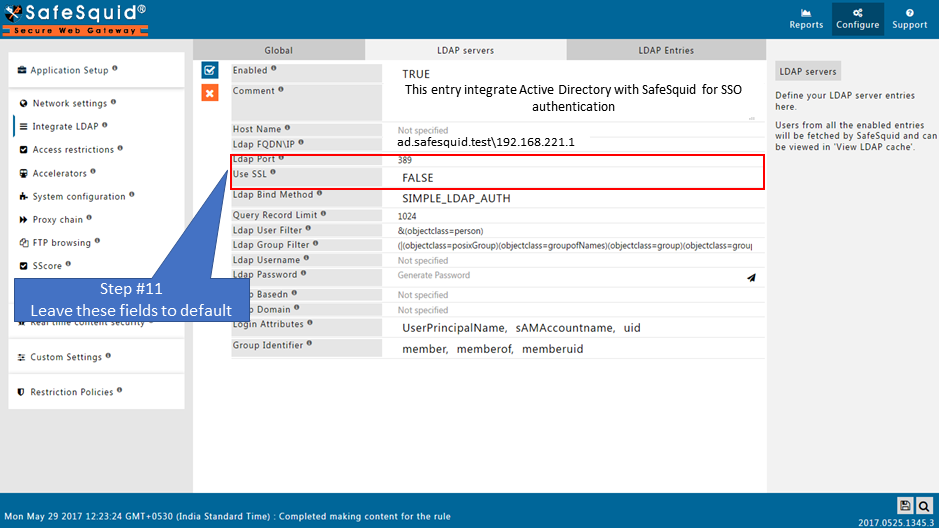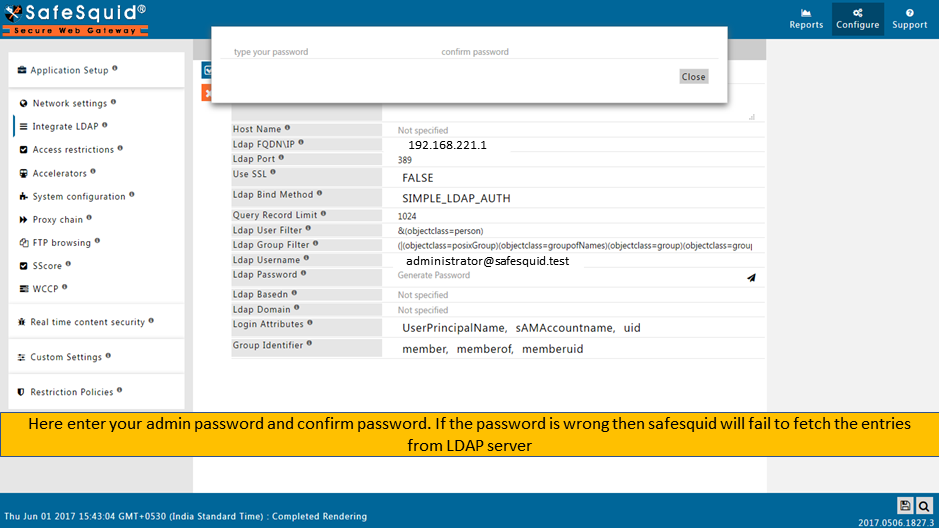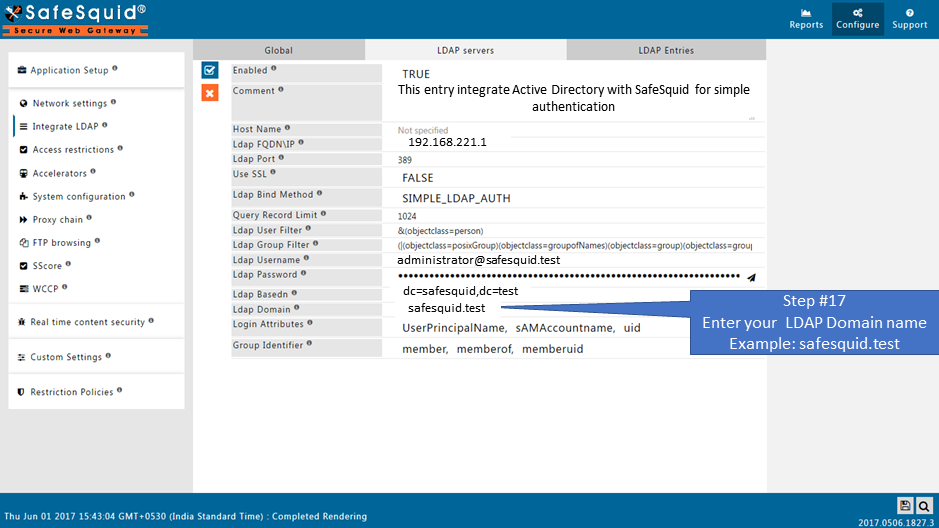Difference between revisions of "Integrate LDAP"
m (1 revision imported) |
|||
| Line 18: | Line 18: | ||
Make sure that all the values (LDAP server FQDN, LDAP server IP, Username, password, base dn, domain ) in configuration are correct. If any value is inappropriate then SafeSquid will fail to fetch the LDAP entries. | Make sure that all the values (LDAP server FQDN, LDAP server IP, Username, password, base dn, domain ) in configuration are correct. If any value is inappropriate then SafeSquid will fail to fetch the LDAP entries. | ||
= <span class="mw-headline" id="Access_the_SafeSquid_User_Interface">[ | = <span class="mw-headline" id="Access_the_SafeSquid_User_Interface">[https://docs.safesquid.com/index.php/Access_The_SafeSquid_User_Interface Access the SafeSquid User Interface]</span> = | ||
{| border="0" cellpadding="1" cellspacing="1" style="width: 100%" | {| border="0" cellpadding="1" cellspacing="1" style="width: 100%" | ||
Latest revision as of 15:16, 15 June 2022
Integration of LDAP
Here I am integrating my Active Directory with following information.
Active Directory FQDN : ad.safesquid.test
IP Address : 192.168.221.1
User Name : administrator@safesquid.test
Domain of Active Directory : safesquid.test
Basedn : dc=safesquid,dc=test
Prerequisites
Make sure that all the values (LDAP server FQDN, LDAP server IP, Username, password, base dn, domain ) in configuration are correct. If any value is inappropriate then SafeSquid will fail to fetch the LDAP entries.
Access the SafeSquid User Interface
 |
|
Go to Application Setup |
|
Go to Integrate LDAP |
|
GlobalIntegrate with Microsoft Active Directory or OpenLDAP. SafeSquid can also use the Directory Server for authenticating the users. This will be useful specially when a user cannot be authenticated via Kerberos/SSO.  |
|
|
Enabled Enable or Disable the use of LDAP
 |
|
 |
|
 |
|
LDAP serversYou can configure more than one LDAP server here Users from all the enabled entries are fetched by SafeSquid and can be viewed in 'LDAP Entries'.  |
|
Create the New LDAP entry |
|
|
Enabled Enable or Disable this entry.
|
|
Comment For documentation, and future references, explain the relevance of this entry with your policies. That is, by reading the policies, a future user can understand the purpose of that entry.  |
|
|
Host Name Specify host name of the SafeSquid. In a network with multiple LDAP Servers, and multiple SafeSquid Proxy Servers deployed in Master-Slave mode, this field can be used to specify the Host Name of the Proxy Server, which communicates with the LDAP Server configured. Leave this field blank if this is the only SafeSquid proxy, or if you want all the proxies to communicate with the LDAP server configure. |
|
|
Ldap FQDN\IP Enter FQDN of LDAP Server.
 |
|
 |
|
|
Ldap Port Specify the Port for LDAP service. Default Ldap Port is 389. Use SSL Communicate with LDAP service using TLS protocol by copying LDAP service CA certificate into security directory and rename CA certificate to LDAP_CA_FILE.cer file. Note: If you do not wish to verify server certificate then do not mention CA certificate. SafeSquid performs SSL without requesting server certificate.
 |
|
Ldap Bind Method Choose the best method for Binding (authenticating) with your Directory Server according to appropriate binding mechanisms.  |
||||||||||||||
 |
||||||||||||||
|
Query Record Limit Specify the maximum number of records that should be fetched in a single LDAP query. Ldap User Filter SafeSquid applies LDAP user filter to narrow the scope of entries requested, to search the users in the LDAP. By default configuration, LDAP server returns only entries that necessarily match the requirement of objectclass="person and" also have at least one of the attributes of UserPrincipalName or sAMAccountname or uid set. Ldap Group Filter Specify the LDAP Group Filter. This is required if the LDAP server does not support Reverse Group Membership. Note: Microsoft Windows AD server normally supports Reverse Group Membership. Legacy OpenLDAP implementations may not have support for Reverse Group Membership. If the LDAP server supports Reverse Group Membership then leave this field blank. SafeSquid will apply this filter to narrow the scope of entries requested, to search the groups in the LDAP. For example if : LDAP Group Filter : (|(objectclass="posixGroup)(objectclass=groupofNames)) and, Group" Identifier : member, members, memberof |
||||||||||||||

|
||||||||||||||
|
Ldap Username Specify any one Username to bind LDAP Server. Most OpenLDAP servers allow binding anonymously. In such cases, you may leave this blank.  |
||||||||||||||
|
Ldap Password Specify the Encrypted Password for the above username to bind to Microsoft AD or LDAP Server. When you click on 'Utilities', you will get a dialog box to enter password for encrytion. Click on 'Encrypt' button to proceed with password encryption process. For Example : Test1 is an user present in Microsoft AD Servers. Enter same password for user Test1, encrypt the password and copy the encrypted password. 

Note: You can use Search Text Box to search users from AD(Active Directory) / Open LDAP. Login Attribute menu is used to search users or OU(Organizational Unit) from AD(Active Directory) / Open LDAP. |





